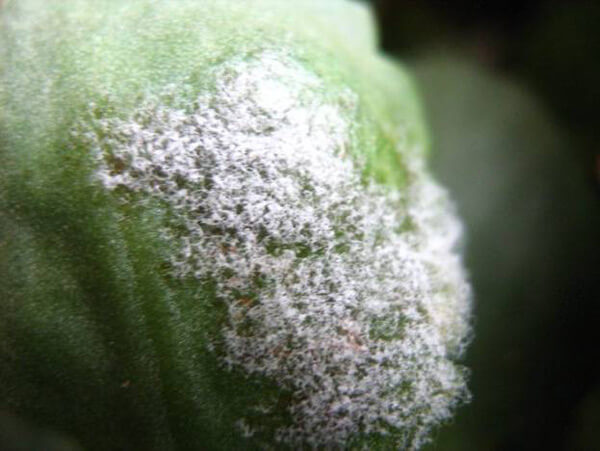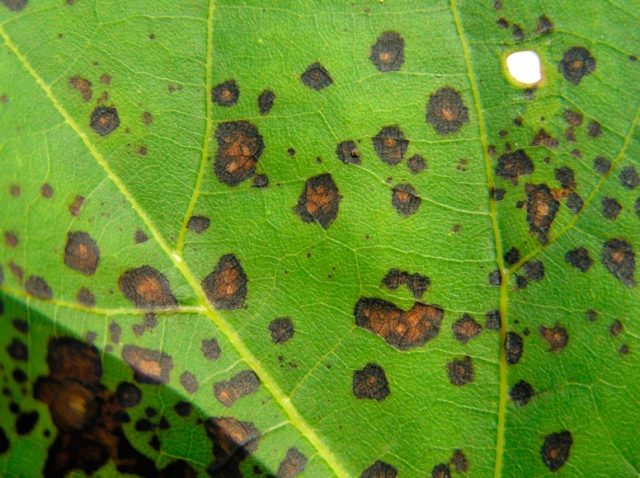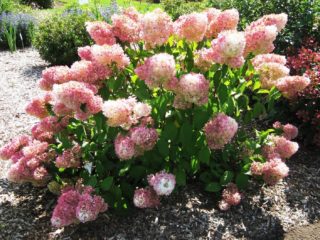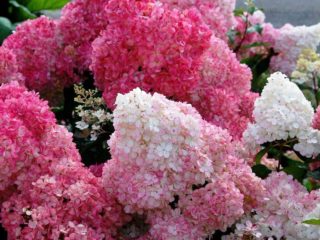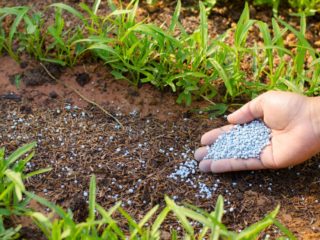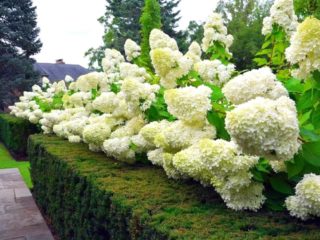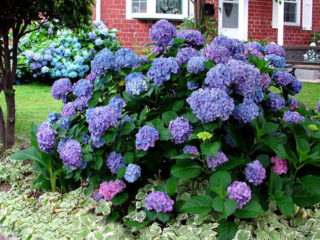Content
Gardeners have poor hydrangea growth not only due to insufficient care, but also for other reasons. This is a whimsical garden and indoor crop that requires good care. Poor growth may be caused by poor-quality seedlings, unfavorable weather conditions, lack of fertilizing, or emerging diseases.
Why does hydrangea grow poorly?
There may be several reasons why a crop grows poorly. The first and most important thing is to plant a weak, low-quality flower. It is important for beginning gardeners to carefully select planting material for their flower garden.
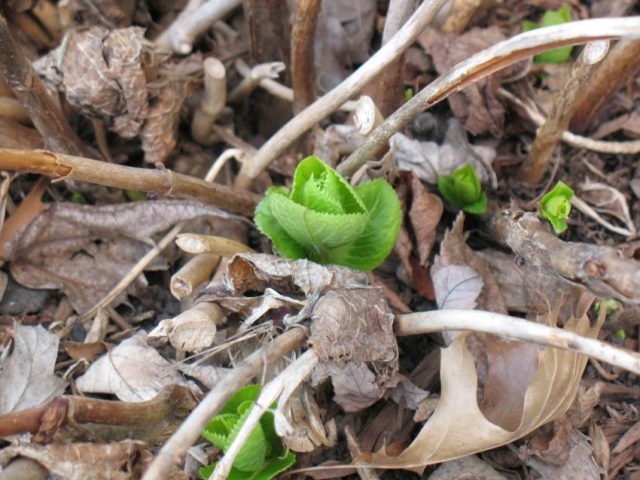
Modern varieties that are now presented in nurseries have different winter hardiness, bush sizes, shape and arrangement of inflorescences
Climatic conditions play an important role in the growth rate of hydrangeas. The culture prefers the southern regions of Russia; it takes root well in the central regions.In areas with frosty, little snow winters, the flower does not grow, even with good shelter.
Dry, dense, low acidity soil is not suitable for these plants. It is important to choose a planting location carefully; it is necessary to take into account all the needs of a whimsical plant.
Lack of fertilizers, untimely pruning and infrequent watering will not have the best effect on the growth of hydrangeas. With insufficient care, some of them not only slow down their growth, but also die.
Reasons why garden hydrangea grows poorly
To create ideal conditions, it is important to take into account the factors that inhibit crop growth. Even the wrong planting technology (too deep) will slow down the growth of the seedling for several seasons. Often hydrangea does not grow in height precisely for this reason.
Wrong choice of seedling
Most often, gardeners choose hydrangeas impulsively, rooting shrubs according to aesthetic tastes. Before purchasing, it is important to find as much information as possible about the characteristics of the variety you like. Winter hardiness is the main criterion by which this plant is chosen. Many varieties of flowering shrubs simply cannot tolerate the cold.

Dry regions where it is difficult to find water for irrigation are also not suitable for hydrangeas.
The flower loves abundant moisture in the root system, without stagnation of moisture.
Improper care
The life of hydrangea on a personal plot begins with planting. This is an important stage for the rooting of the seedling. It is important to choose a place that is well lit or slightly sheltered from direct sunlight. It is better to plant in the spring, so the crop will have time to take root and take root before the onset of frost. The soil should be well dug and moistened.
This is a moisture-loving plant that does not tolerate drying out of the soil. At elevated air temperatures (above + 30 ᵒC) and lack of moisture, large-leaved hydrangea does not grow.
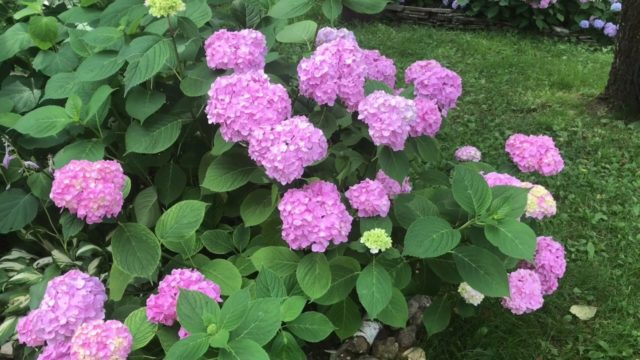
In summer, this type of watering is carried out regularly, at least 3 times a week.
The lack of mineral and organic fertilizers leads to inhibition of the growth of hydrangeas older than 2 years. In the first years after planting, the shrub absorbs the beneficial substances that were contained in the planting hole. Later, the plant is fertilized during the warm period of the year at least once a month. In this case, mineral compositions alternate with organic matter, nutritious watering and spraying.
Loosening is carried out before or after watering. This is necessary to provide air access to the rhizome and facilitate its growth. It is enough to carry out the procedure 3 times in the summer. The soil is loosened carefully, without going too deep, as there is a possibility of damage to the roots; they are located almost on the surface of the soil in the bush.
Hydrangeas need pruning. Some varieties of shrubs are thinned out in the spring, while others are thinned out in the fall. For example, after autumn pruning, paniculata hydrangea does not grow.
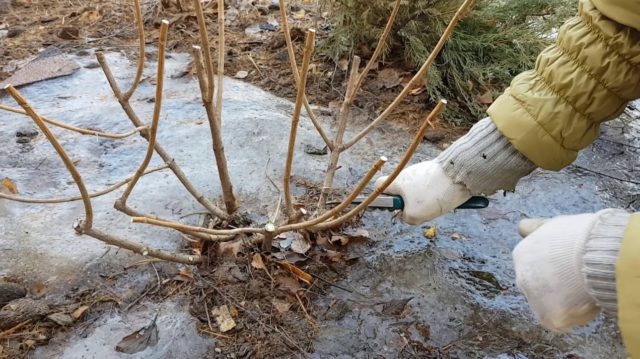
The paniculate species is pruned only in the spring, before the buds begin to form.
Radical pruning of serrated, large-leaved and prickly hydrangeas in the fall will slow down their growth. These varieties lay buds on last year's shoots; shortening the stems leads to a cessation of growth and flowering.
Adverse weather conditions
Insufficiently warm summers with winds, frequent rains and temperature changes negatively affect the growth of hydrangeas. Wintering is especially important for flowering shrubs.Any hypothermia is fraught with the death of the plant.
During rainy summers, watering should be stopped. An excess of moisture and its stagnation at the root leads to the death of the bush.
Diseases and pests
Attacks of harmful insects and the appearance of diseases lead to the fact that hydrangeas do not grow. In advanced cases, culture may disappear altogether.
Dangerous fungal diseases:
- gray rot;
Damaged plant tissues soften, become watery, and can dry out in dry weather
- septoria;
Small rusty spots form on the surface of the leaf; as they grow, the leaves fly off, the crop loses its decorative qualities and does not grow
- chlorosis;
The disease occurs due to a lack of iron in the soil, and, as a result, metabolic disorders begin, the flower does not grow
- powdery mildew.
The disease affects young, immature plants and occurs from an excess of nitrogenous fertilizers and lack of moisture.
Fungicide preparations will help protect the crop from fungus: Fundazol, Ferovit, Topaz, Skor.
Slugs and snails are dangerous for garden hydrangea; they are selected manually.

Pests occur when hydrangea plantings are dense; slugs and snails destroy the green part of the bush, after which it does not grow
To combat garden pests, insecticides are used: Decis, Actellik, Kleschevit. The drugs are also effective against worms, ticks, and flying harmful insects.
What to do if hydrangea does not grow
If after planting the shrub retains its original size for a long time, you need to pay attention to the composition of the soil and the abundance of sunlight. To accelerate the growth of hydrangeas, fertilizers with iron and nitrogen are added to the soil, and mineral complexes are added to the soil before flowering.
Sunlight is also important for the growth of any variety of hydrangea. Each of them develops well in partial shade, but petiole hydrangea does not grow in the sun. She prefers completely shaded, windless areas with acidic, loose, humus-rich soil.
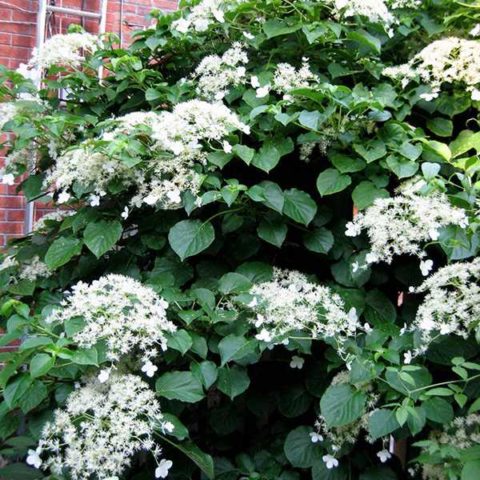
The first few years, even with successful planting, petiole hydrangea grows slowly
In calcareous soils with insufficient acidity, any variety will not grow. Also, chernozems, soil fertilized with manure or humus, are destructive for the crop.
Watering is especially important for the growth of hydrangea - this crop quickly dies during drought. Moisten the bush with a watering can. The water should be dispersed so as not to expose the plant's surface roots. The liquid is pre-settled; it should not be cold.
Watering is carried out only in the early morning or evening, after sunset. The fastidious crop should not be exposed to sunlight after moistening. An adult bush needs 1-2 buckets of water per procedure. In hot summers, watering is carried out every other day or 2 times a week. Only with plenty of moisture does the shrub grow well.
If gray, whitish or rusty spots appear on the leaves of the hydrangea, this is a fungal disease. Because of this, the shrub grows weakly and stops blooming. The bush is sprayed with fungicides 1-2 times a week until signs of the disease completely disappear.
A garlic-soap solution will rid the plant of any pests.It is prepared like this: 0.5 kg of garlic is peeled, the cloves are crushed in a blender. The resulting slurry is poured into 2 liters of water and left for 2 days. Afterwards, grate a bar of laundry soap and combine it with infused and strained garlic water. The liquid is sprayed on garden plants, cleaning them from slugs, snails, leaf rollers, and spider mites.
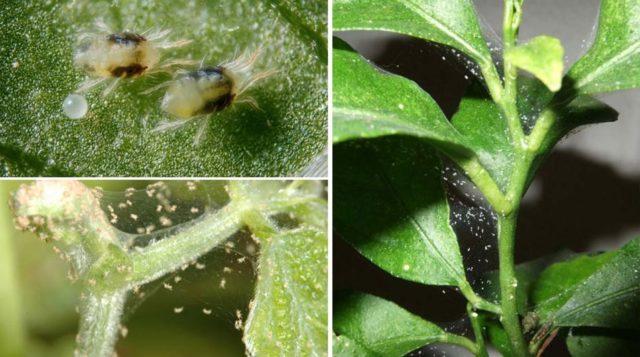
Hydrangea leaves affected by mites dry out and fall off, after which the crop does not grow
Fufan or Teofos insecticides are also used to control the pest.
In spring, it is important to prune hydrangeas to speed up the growth of young shoots. In the fall, it is better not to remove the branches of the current year, since it is on them that the flower buds of the next season are laid.
Serrated, oak-leaved, and prickly hydrangeas are trimmed minimally (only the tips of old shoots). Thorough pruning can stunt the growth of these types of hydrangeas.
Timely covering of hydrangeas for the winter will preserve the integrity of the shoots and flower buds. In the new season, such a flower will grow well, releasing leaves when the first rays of the sun appear.
Tree and paniculate hydrangeas are characterized by increased frost resistance; in the southern and central regions of Russia they are not covered. For a successful wintering of these crops, it is enough to mulch the tree trunk well.
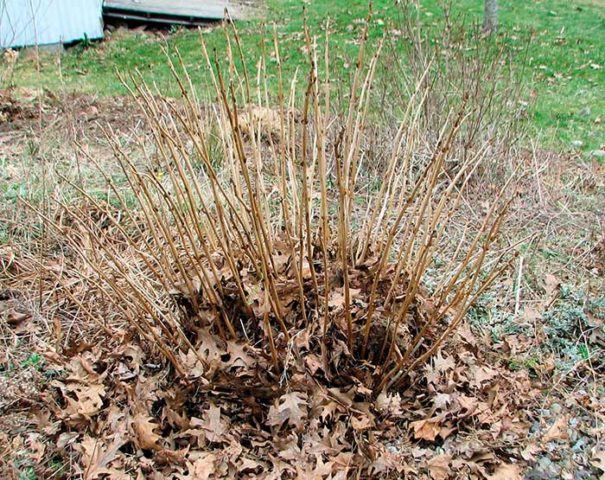
Top the mulch with a thick layer of dry fallen leaves.
All other types of hydrangeas require multi-layer cover for the winter. If the crop successfully overwinters and does not freeze, it will grow well in the spring and bloom early.
How to feed hydrangea if it does not grow
Lack or excess of fertilizers negatively affects the growth of shrubs.After planting, for the first 2 years it does not need fertilizing; enough of it is added to the hole, and the crop grows actively.
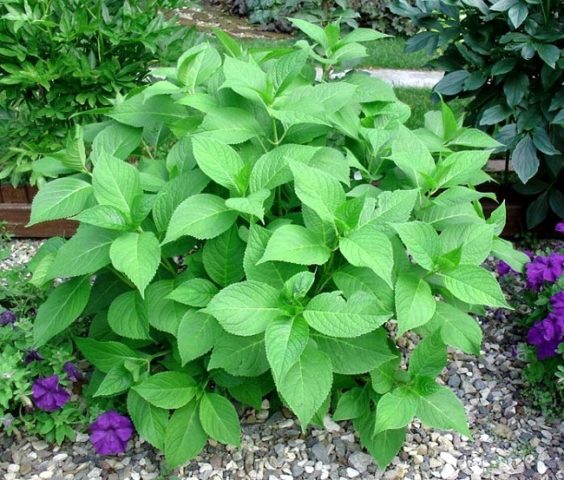
Mature plants older than 2 years grow poorly due to lack of nutrition
The lack of nutrients can be determined by thin shoots, pale and limp leaves, and the absence of buds.
Nitrogen fertilizers applied to the bush in early spring, before flowering, will help speed up growth. As soon as the buds begin to form, the hydrangea is watered with complex mineral fertilizers. Their composition should contain large quantities of potassium and phosphorus (a mixture of potassium sulfate and urea), and a small part of nitrogen.
Large-leaved and paniculate hydrangeas develop well in acidic soils. To do this, the soil is shed once a month with a weakly acidic solution of vinegar or lemon juice.
You can make hydrangea grow even in unsuitable soil if you water it with copper sulfate several times a season. To do this, 6 g of the substance is diluted in a bucket of water.
Advice from experienced gardeners
Good care and the right variety of hydrangea in accordance with climatic conditions are the key to rapid growth and lush flowering of the ornamental shrub. These rules work if you take into account the recommendations of experienced flower growers.
Hydrangea grows poorly if:
- the heat-loving variety is cultivated in regions with cold and short summers;
- When planting, the root shoots were cut off and the soil was shaken off;
- the planting hole is not made deep, the moisture quickly evaporates, and the flower experiences a lack of it;
- the flower is grown in open areas, under the scorching sun;
- the bush was planted in the midst of other crops, it does not have enough space to grow;
- during the flowering period, hydrangea is fertilized with organic matter;
- The bush is not pruned in early spring.
Hydrangea has a hard time with transplants, after which it gets sick for a long time and does not grow. There is no need to disturb the plant in vain.
Conclusion
It is difficult for inexperienced gardeners to figure out why hydrangea grows poorly. There are many reasons for this. It is important to seriously study the conditions for good growth and flowering of this crop. She is whimsical, susceptible to the influence of many unfavorable factors. But the result is worth the trouble, because hydrangea in bloom will not leave anyone indifferent.
